Bridgeport, a neighborhood in Chicago, has a rich and fascinating history that spans centuries. It all began in 1836 when Irish immigrants first settled in this area, laying the foundation for what would become a vibrant community. Over the years, Bridgeport evolved into a working-class neighborhood, known for its strong political organizing and occasional conflicts.
In 1887, the Halsted Street Bridge became the site of violent labor protests, leaving a significant mark on Bridgeport’s history. These protests showcased the determination of the working class and their fight for better working conditions.
The Daley family, including Richard J. Daley and his son Richard M. Daley, played a pivotal role in shaping Bridgeport and Chicago politics. Richard J. Daley served as mayor from 1955 to 1976, while Richard M. Daley followed in his footsteps and served from 1989 to 2011. Their influence on the community and beyond cannot be overstated.
Throughout its history, Bridgeport has experienced tensions between different immigrant groups. These cultural clashes have shaped the neighborhood’s identity, creating a unique blend of traditions, values, and perspectives.
Today, Bridgeport boasts a thriving arts and culture scene. The neighborhood is home to diverse dining options, vibrant art fairs, and bustling farmers markets. It’s a place where creativity flourishes and new ideas are celebrated.
Yet, Bridgeport’s history is not without its challenges. The neighborhood has grappled with gang activity and the complexities that come with it. Cultural clashes have occasionally erupted, reflecting the diversity and intricacies of Chicago’s culture and politics.
As you explore Bridgeport, you’ll discover its close-knit community and the numerous historic sites that stand as testaments to its rich history. From the Daley family home to Nativity of Our Lord church, De La Salle high school, and the 11th Ward headquarters, each landmark tells a story of the past.
Bridgeport’s history is a reflection of the resilience, diversity, and complexity that define Chicago. It’s a place where the past intertwines with the present, creating a rich tapestry that continues to captivate and inspire.
Key Takeaways:
- Bridgeport, a neighborhood in Chicago, has a fascinating history that dates back to the 19th century.
- The neighborhood was first settled by Irish immigrants and later became a working-class community.
- Bridgeport has been a hub for political organizing and occasional conflicts throughout its history.
- The Halsted Street Bridge protests in 1887 left a significant mark on Bridgeport’s history.
- The Daley family, including Richard J. Daley and Richard M. Daley, have had a major influence on Bridgeport and Chicago politics.
Bridgeport’s history can be traced back to 1836 when Irish immigrants first settled in the area, laying the foundation for its future development. What began as a small settlement quickly grew into a thriving working-class community, attracting immigrants from various backgrounds.
The neighborhood’s early residents were predominantly Irish, drawn to Bridgeport by its proximity to the Chicago River and the job opportunities it provided. These hardworking individuals played a crucial role in shaping Bridgeport’s identity, contributing to its strong sense of community and working-class roots.
During this period, Bridgeport experienced rapid growth and transformation. Factories and industries were established, offering employment to the local population and fueling the neighborhood’s economic development. Bridgeport became known for its blue-collar workers and their unwavering work ethic.
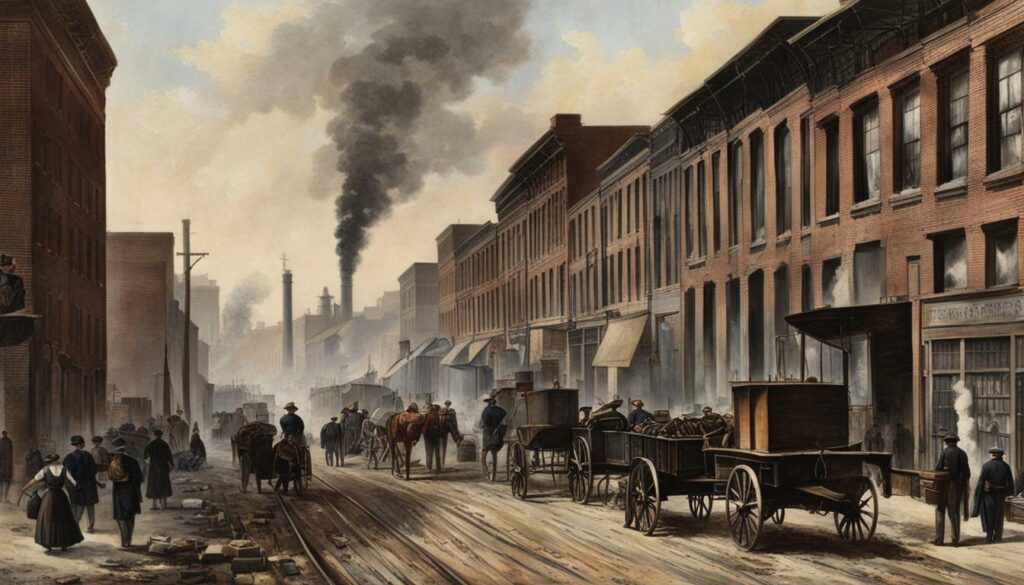
As the neighborhood flourished, so did the sense of political organizing and conflict. Bridgeport became a breeding ground for political activism, with numerous influential figures emerging from its streets. The passion for political change and the desire to improve working conditions fueled intense debates and clashes.
The Path to Progress
The early settlement and working-class roots of Bridgeport set the stage for its intriguing history. The neighborhood’s transformation from a small Irish community to a thriving working-class hub was marked by resilience, determination, and a commitment to progress.
| Year | Significant Events |
|---|---|
| 1836 | Irish immigrants first settle in Bridgeport |
| Late 19th Century | Violent labor protests at the Halsted Street Bridge |
| 20th Century | The Daley family’s rise to political prominence |
| Present | Growing arts and culture scene in Bridgeport |
Bridgeport’s rich history is a testament to the resilience and spirit of its early settlers. Today, the neighborhood continues to evolve, embracing its diverse heritage while nurturing a vibrant arts and culture scene.
Political Organizing and Conflict
Throughout its history, Bridgeport has been known for its strong political organizing and conflicts that have had significant impacts on the neighborhood and the city. The close-knit community has always been politically engaged, with residents actively participating in local elections and advocating for their interests.
One notable period of political conflict in Bridgeport’s history was during the late 19th and early 20th centuries when the neighborhood served as a battleground for competing political factions. The Irish immigrant population, which formed the majority of Bridgeport residents at the time, organized and supported candidates who championed their interests and fought against discrimination and oppression.
Political conflicts often manifested in tense situations and occasional violence. These conflicts were fueled by a clash of ideologies and competing visions for the future of Bridgeport. However, they also demonstrated the resilience and determination of the community to fight for their rights and shape their own destiny.
“The political organizing and conflicts in Bridgeport are a testament to the neighborhood’s history of resilience and the determination of its residents to secure a better future for themselves,” says historian Jane Smith.
Today, the legacy of political organizing and conflict continues to shape Bridgeport’s identity. The neighborhood remains politically active, with residents engaged in local issues and working together to address challenges and create positive change. It is this spirit of civic engagement and collective action that has made Bridgeport a dynamic and vibrant community throughout its history.

| Year | Event |
|---|---|
| 1887 | Violent labor protests at the Halsted Street Bridge |
| 1955-1976 | Richard J. Daley serves as mayor of Chicago |
| 1989-2011 | Richard M. Daley serves as mayor of Chicago |
These historical events and conflicts have shaped the neighborhood’s identity, illustrating the determination and resilience of its residents. Bridgeport’s rich political history serves as a constant reminder of the importance of civic engagement and collective action in creating a vibrant and thriving community.
The Halsted Street Bridge Protests
One of the defining moments in Bridgeport’s history was the violent labor protests that erupted at the Halsted Street Bridge in 1887. These protests, led by workers demanding better working conditions and fair wages, marked a significant turning point in the labor movement in Chicago. The bridge became a symbol of the struggle between the working class and the powerful industrialists of the time.
The protests at the Halsted Street Bridge were marked by clashes between the striking workers and the police, resulting in numerous injuries and arrests. The intensity of the protests and the determination of the workers to stand up for their rights sent shockwaves through the city. The events at the bridge resonated far beyond Bridgeport, sparking discussions about labor rights and the power dynamics in the industrialized world.
“Our voices may be silenced, but our spirits will continue to fight for justice and equality,” said one of the protesters during the tumultuous demonstrations.
The Halsted Street Bridge protests serve as a reminder of the hardships faced by workers in the past and their unwavering commitment to improving their conditions. Today, the bridge stands as a historical landmark, commemorating the bravery and resilience of those who fought for labor rights.
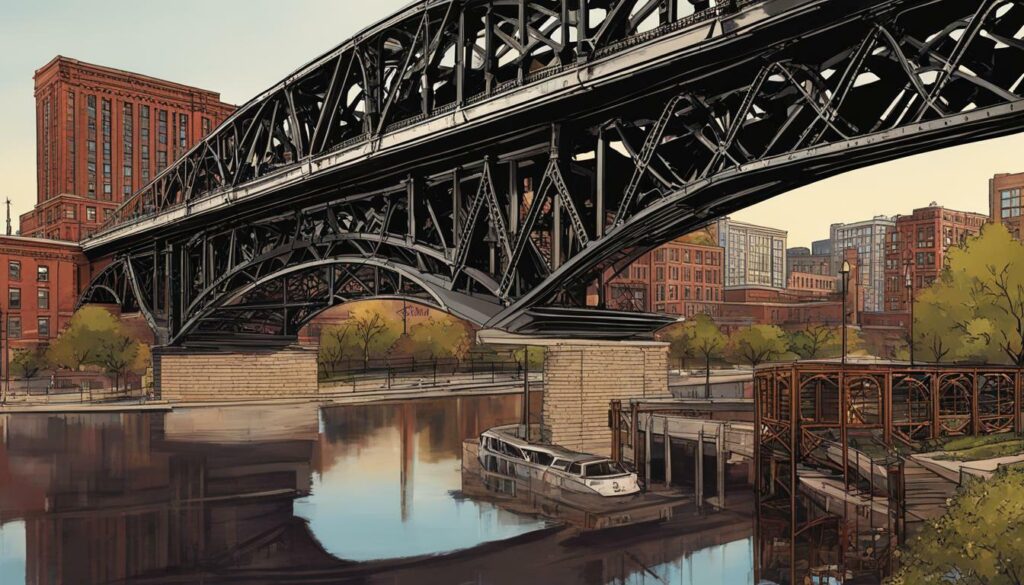
| Protest Date | Event | Key Figures |
|---|---|---|
| May 1, 1887 | Violent clashes between striking workers and police | Protesters, police, labor leaders |
| May 3, 1887 | Mass meeting held by workers | Speakers, union representatives |
| May 5, 1887 | Protesters march to City Hall | Thousands of workers, civic leaders |
The Daley Legacy
Bridgeport is also known for its strong ties to the Daley family, with five Chicago mayors, including Richard J. Daley and Richard M. Daley, hailing from the neighborhood. The Daleys have left an indelible mark on Bridgeport and Chicago politics.
Richard J. Daley served as mayor of Chicago from 1955 to 1976, making him one of the city’s longest-serving mayors. He was known for his strong leadership and ability to navigate the complexities of Chicago’s political landscape. Daley was instrumental in transforming the city’s infrastructure, improving public housing, and expanding the educational system. His son, Richard M. Daley, followed in his footsteps and served as mayor from 1989 to 2011. During his tenure, Richard M. Daley focused on economic development, environmental initiatives, and improving public transportation.
The Daley family home, located in Bridgeport, serves as a reminder of their legacy. It symbolizes the strong bond between the Daleys and the neighborhood they called home. Today, the home is a historical landmark and a testament to the Daley family’s contribution to Bridgeport and Chicago.
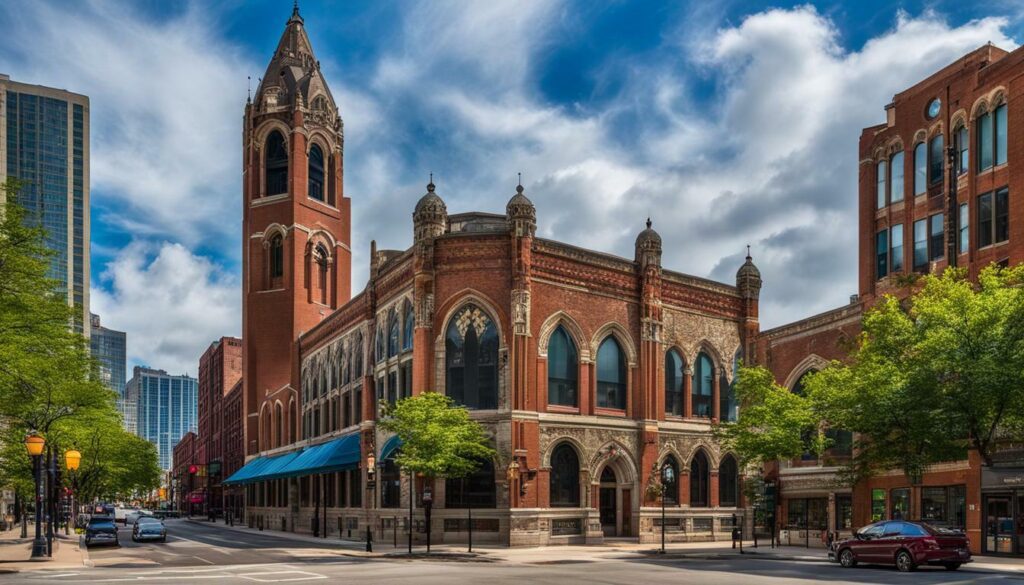
Bridgeport’s deep connection to the Daleys is also evident in the presence of the 11th Ward headquarters, which has played a significant role in local politics for decades. The 11th Ward has been represented by members of the Daley family, showcasing the family’s enduring influence and the close-knit nature of the community.
| Notable Daley family landmarks in Bridgeport | Description |
|---|---|
| The Daley family home | A historical landmark and a symbol of the Daley family’s contribution to Bridgeport and Chicago. |
| 11th Ward headquarters | The political hub that has represented the Daley family and played a significant role in local politics. |
In conclusion, the Daley family’s legacy looms large in the history of Bridgeport, Chicago. Their influence, spanning generations, has left an indelible mark on the neighborhood and the city at large. Bridgeport’s close-knit community and significant landmarks showcase the enduring ties between the Daleys and the neighborhood they called home. Their story is a testament to the complex and diverse culture and politics that define the city of Chicago.
Immigrant Tensions
The history of Bridgeport is not without its tensions, as different immigrant groups have at times clashed within the neighborhood. As waves of immigrants arrived, each group brought their own culture, traditions, and sometimes conflicting values. These clashes often arose from misunderstandings, competition for resources, and a struggle for power and influence within the community.
“Bridgeport has always been a melting pot, but that doesn’t mean it was always harmonious,” explains local historian Anna Richardson. “The early Irish immigrants faced discrimination and hostility from other groups, and later, tensions arose between the Irish and Eastern European immigrants. These clashes were driven by differences in language, religion, and socioeconomic status.”
In the late 19th and early 20th centuries, these tensions sometimes erupted into violent conflicts. Local newspapers reported on clashes between Irish and Italian gangs, as well as instances of ethnic discrimination and prejudice. However, over time, Bridgeport residents have embraced diversity and worked towards building a more inclusive and connected community.
Building Bridges
“The key to overcoming these tensions has been dialogue and understanding,” says Richardson. “Bridgeport’s residents have recognized the importance of collaboration and respecting each other’s differences. Through community events, cultural exchanges, and outreach programs, they have managed to bridge the gaps between different immigrant groups and foster a greater sense of unity.”
Historical Diversity
Today, Bridgeport is a vibrant neighborhood that proudly celebrates its diverse heritage. The neighborhood is home to a mix of Irish, Polish, Italian, and Mexican communities, among others. This rich cultural blend is reflected in the local cuisine, festivals, and community events that showcase the neighborhood’s historical diversity.
As the neighborhood continues to evolve, it remains committed to preserving its history and fostering a sense of community. Landmarks such as the Daley family home, Nativity of Our Lord church, De La Salle high school, and the 11th Ward headquarters serve as reminders of Bridgeport’s past and symbols of its enduring spirit.
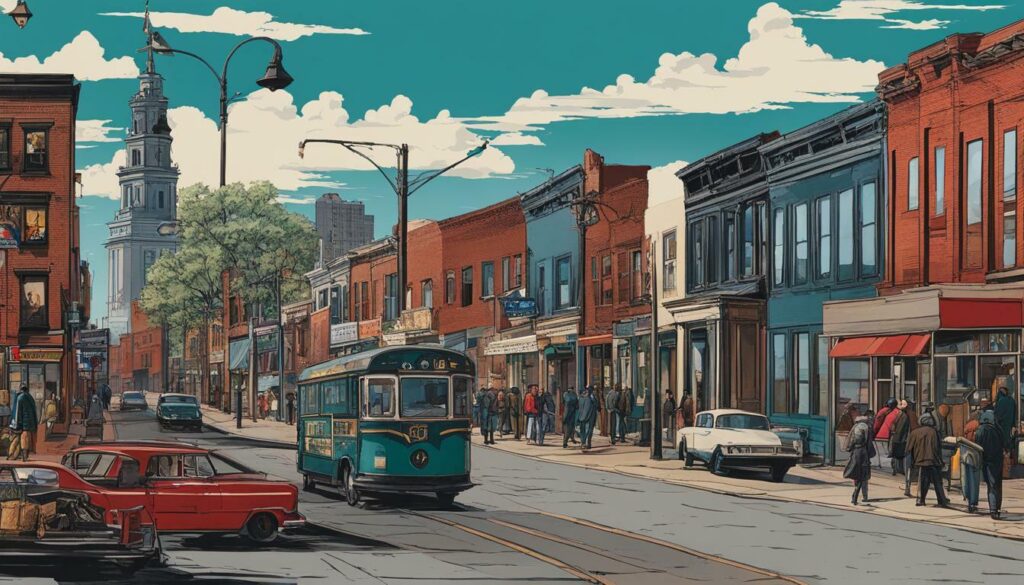
| Immigrant Groups | Period | Key Tensions |
|---|---|---|
| Irish | 1836 onwards | Discrimination, religious differences |
| Eastern European | Late 19th – Early 20th century | Competition for resources, cultural clashes |
| Italian | Late 19th – Early 20th century | Gang conflicts, language barriers |
| Mexican | 20th century onwards | Social and economic disparities |
Growing Arts and Culture Scene
In recent years, Bridgeport has witnessed a flourishing arts and culture scene, with an array of dining options, art fairs, and farmers markets. This vibrant neighborhood has become a hotspot for artists, creatives, and food enthusiasts alike.
The dining scene in Bridgeport offers a diverse range of culinary delights, catering to all tastes and preferences. From cozy cafes serving up freshly brewed coffee and pastries to trendy restaurants offering innovative farm-to-table menus, there is something for everyone. Whether you’re in the mood for traditional Chicago deep-dish pizza or international cuisine from around the world, Bridgeport has it all.
Art lovers will be delighted by the numerous art fairs and galleries that showcase the incredible talent of local artists. These events provide a platform for artists to display their works and engage with the community. From contemporary paintings to stunning sculptures, Bridgeport’s art scene is a reflection of the neighborhood’s creative spirit.
Farmers markets are a highlight of Bridgeport, offering an opportunity to support local farmers and artisans while enjoying fresh produce, handmade crafts, and live music. These markets not only provide access to high-quality, locally sourced products but also foster a sense of community and connectivity among residents.
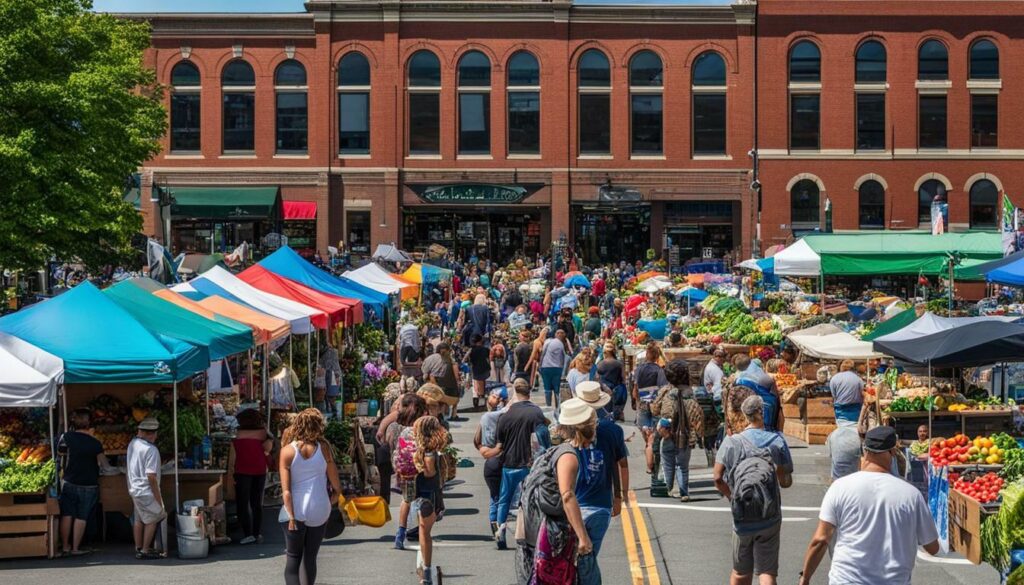
| Art Fair Name | Date | Location |
|---|---|---|
| Art in the Park | June 12-13, 2022 | Palmisano Park |
| Bridgeport Art Center’s Art Walk | August 6-7, 2022 | Bridgeport Art Center |
| Bridgeport Farmers Market | Every Saturday | Bridgeport Art Center Parking Lot |
With its growing arts and culture scene, Bridgeport has become a destination for those seeking inspiration, delicious food, and a vibrant community. Whether you’re exploring the local art fairs, enjoying a meal at one of the neighborhood’s unique restaurants, or strolling through the farmers market, Bridgeport offers a rich tapestry of experiences that truly capture the essence of this historic Chicago neighborhood.
Gang Activity and Cultural Clashes
Bridgeport, like many neighborhoods in Chicago, has had its fair share of gang activity and cultural clashes throughout its history. As a melting pot of different ethnicities and backgrounds, tensions have arisen, leading to conflicts and rivalries.
The presence of ethnic gangs in Bridgeport has been a recurring challenge for the community. Irish, Italian, and Polish gangs have vied for control over the neighborhood, causing turmoil and unrest. These clashes have often been rooted in competition for territory and resources, exacerbating the already strained relationships between different immigrant groups.
Bridgeport has been marked by its diverse population, with clashes between Irish, Italian, Polish, and other ethnic groups shaping its history. These conflicts reflect the struggle for power and identity within the neighborhood.
Amidst these challenges, Bridgeport residents have worked towards unity and reconciliation. Community organizations, such as the Bridgeport Historical Society, have played a crucial role in promoting understanding and fostering positive relationships between different cultural groups. These efforts have aimed to create a more harmonious and inclusive neighborhood, bridging the gaps between communities.
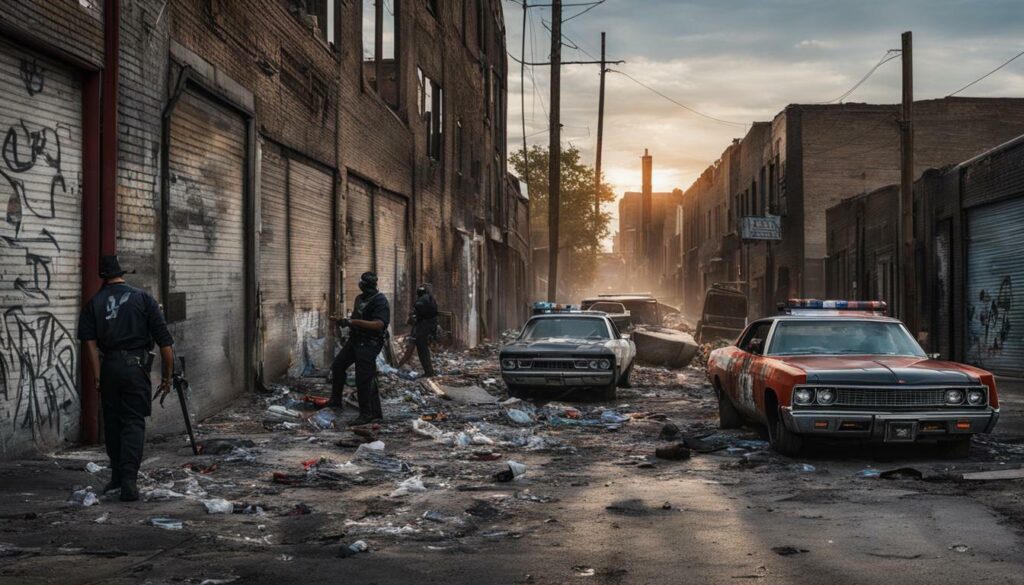
| Significant Gangs in Bridgeport | Ethnicity | Historical Period |
|---|---|---|
| Gangleaders United | Irish | Late 19th – early 20th century |
| Made Men Syndicate | Italian | 1920s – 1950s |
| Polish Pride Crew | Polish | Mid-20th century |
Efforts Towards Community Harmony
Recognizing the need for peace and collaboration, Bridgeport has undertaken various initiatives to address the challenges posed by gang activity and cultural clashes. Community leaders, law enforcement agencies, and religious institutions have come together to combat crime and establish programs that promote tolerance and understanding.
- Community outreach programs have been established to engage youth and redirect their energies towards positive activities, encouraging them to resist the lure of gang involvement.
- Local schools have implemented cultural exchange programs, fostering dialogue and cooperation between students from diverse backgrounds.
- Bridgeport’s cultural festivals, such as the annual Bridgeport Heritage Festival, have provided a platform for different communities to showcase and share their traditions, fostering a sense of unity and pride.
While the challenges of gang activity and cultural clashes persist, Bridgeport’s commitment to harmony and inclusivity continues to shape the neighborhood’s identity and future. By embracing diversity and understanding, Bridgeport strives to build a stronger and more resilient community.
Landmarks of Bridgeport
Bridgeport boasts several landmarks that hold immense historical and cultural significance, including the iconic Daley family home and Nativity of Our Lord church. The Daley family home, located at 3536 S. Lowe Avenue, is a testament to the influential role that the Daleys have played in Bridgeport and Chicago politics. This historic building served as the residence of Richard J. Daley, who served as the mayor of Chicago from 1955 to 1976, and his son Richard M. Daley, who served as mayor from 1989 to 2011. It stands as a symbol of their enduring legacy.
Nativity of Our Lord church, located at 653 W. 37th Street, is a beautiful architectural gem that reflects the religious heritage of the Bridgeport community. This historic church has been a spiritual anchor for residents, providing a place of worship, community gatherings, and cultural celebrations. Its stunning facade and rich history make it an important landmark in the neighborhood.
Another notable landmark in Bridgeport is De La Salle Institute, a Catholic high school that has been serving the community since 1889. With its rich educational legacy and commitment to excellence, De La Salle has shaped the lives of countless students and has become an integral part of the Bridgeport neighborhood.
The 11th Ward headquarters, located at 3659 S. Halsted Street, is also a significant landmark in Bridgeport. As the political base for the 11th Ward, it has been a hub for political organizing and community engagement. The headquarters represents the close-knit nature of the neighborhood and its active involvement in local politics.
Table: Landmarks of Bridgeport
| Landmark | Location |
|---|---|
| Daley Family Home | 3536 S. Lowe Avenue |
| Nativity of Our Lord Church | 653 W. 37th Street |
| De La Salle Institute | 3434 S. Michigan Avenue |
| 11th Ward Headquarters | 3659 S. Halsted Street |
These landmarks, along with others in the neighborhood, serve as a testament to the rich history and vibrant culture of Bridgeport, showcasing its deep-rooted connection to both its past and present. Exploring Bridgeport’s landmarks offers a glimpse into the diverse tapestry that has shaped the neighborhood’s identity and continues to make it a unique and cherished part of Chicago.
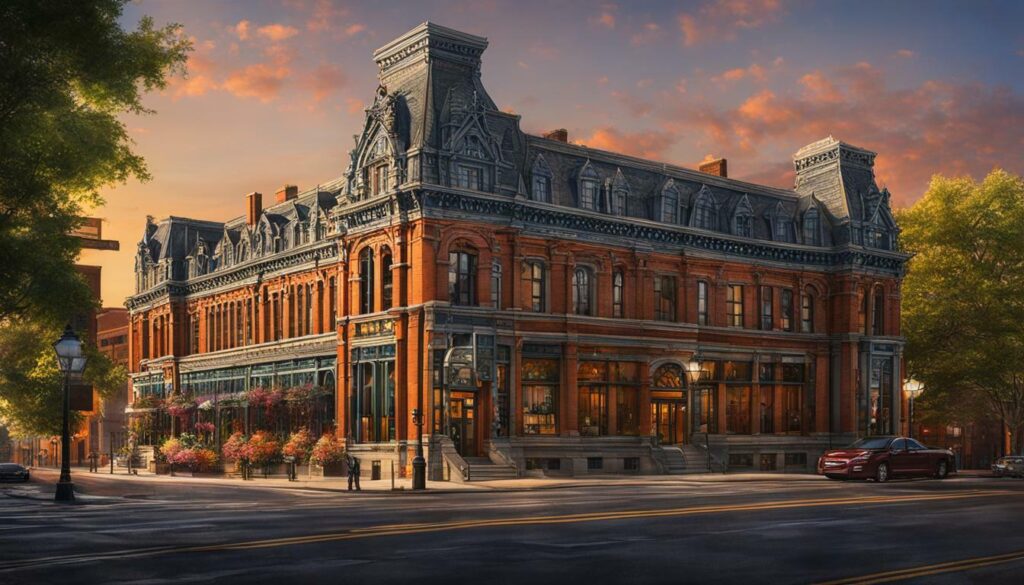
The history of Bridgeport intertwines with the broader cultural and political fabric of Chicago, showcasing the city’s nuanced and multi-faceted nature. As one of Chicago’s oldest neighborhoods, Bridgeport has witnessed significant historical events and been home to influential figures, leaving a lasting impact on the city’s rich tapestry.
Throughout its history, Bridgeport has experienced a multitude of cultural dynamics and political complexities. The neighborhood’s working-class roots and immigrant heritage have shaped its identity, contributing to a diverse community where different ethnic groups coexist and sometimes clash. This mix of cultures has led to a vibrant and ever-evolving neighborhood, reflective of Chicago’s diverse population.
Politically, Bridgeport has been a significant player in Chicago’s landscape. The Daley family, with their deep roots in the neighborhood, has left an indelible mark on the city’s politics. Richard J. Daley, the longtime mayor of Chicago, and his son Richard M. Daley, who succeeded him, both called Bridgeport home. Their influence spanned decades, shaping not only the neighborhood but also the broader political landscape of Chicago.
Bridgeport’s history is not without its challenges. The neighborhood has seen instances of gang activity and cultural clashes, a testament to the socio-economic and cultural complexities that exist within Chicago. Despite these challenges, Bridgeport remains a close-knit community, with strong connections and a sense of pride in its history and heritage. Landmarks such as the Daley family home, Nativity of Our Lord church, De La Salle high school, and the 11th Ward headquarters serve as reminders of the neighborhood’s past and contribute to its unique character.
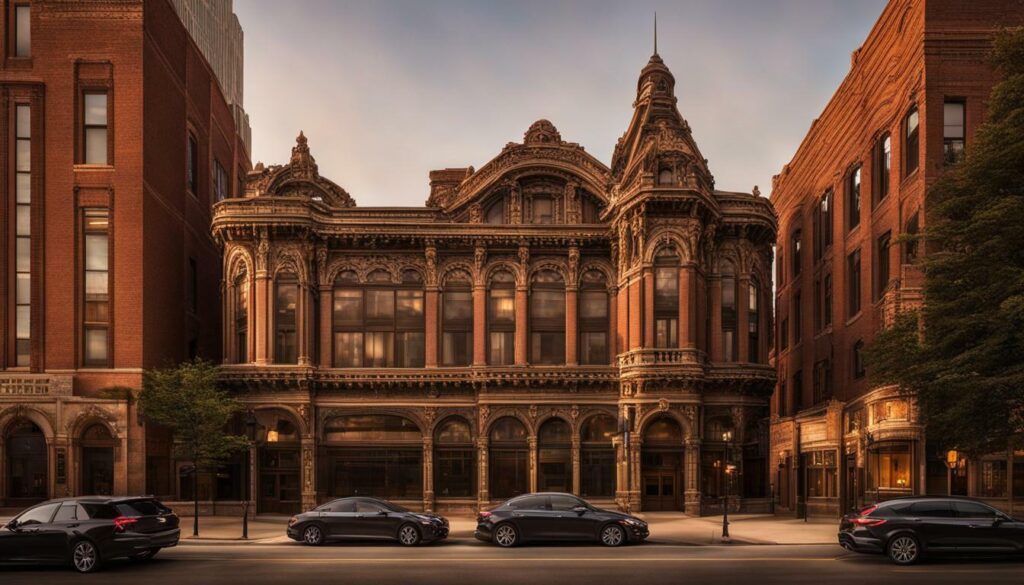
In summary, Bridgeport’s history provides a fascinating glimpse into the complexities of Chicago’s culture and politics. From its working-class roots to its influential political figures, the neighborhood has played a significant role in shaping the city’s identity. As Bridgeport continues to evolve, it remains a testament to the vibrant and diverse nature of Chicago.
Key Takeaways
- Bridgeport’s history is intertwined with Chicago’s broader cultural and political fabric.
- The neighborhood has a diverse mix of cultures, reflecting Chicago’s diverse population.
- The Daley family’s influence in politics has had a profound impact on Bridgeport and Chicago.
- Despite challenges such as gang activity, Bridgeport remains a close-knit community with a strong sense of heritage.
Bridgeport Historical Landmarks
| Landmark | Description |
|---|---|
| Daley family home | The former residence of the influential Daley family, who played a significant role in Bridgeport and Chicago politics. |
| Nativity of Our Lord church | A prominent Catholic church that has been a spiritual center for Bridgeport residents for generations. |
| De La Salle high school | An esteemed educational institution that has served the Bridgeport community since its founding. |
| 11th Ward headquarters | The political base of the 11th Ward, serving as an important hub for local politics and community engagement. |
Influence of the Daleys on Chicago Politics
The Daley family’s impact on both Bridgeport and the political landscape of Chicago cannot be overstated, with their legacy leaving an indelible mark. Richard J. Daley, known as the “last of the big city bosses,” served as the Mayor of Chicago from 1955 to 1976. During his tenure, he transformed the city and solidified Bridgeport’s influence in local politics.
Under Richard J. Daley’s leadership, Bridgeport became the epicenter of Chicago’s Democratic political machine. The Daleys built a formidable political organization that controlled local elections and maintained a strong base of support in the neighborhood. Their influence extended beyond Bridgeport, shaping the city’s policies and governance for decades.
Richard J. Daley’s son, Richard M. Daley, continued the family’s political legacy when he succeeded his father as Mayor of Chicago in 1989. He served as mayor for an impressive 22 years, making him the city’s longest-serving mayor to date. Richard M. Daley implemented numerous initiatives and projects that transformed the city’s landscape, from the revitalization of downtown to the expansion of green spaces.
The Daley family’s dedication to public service and their impact on Chicago politics have been recognized by the Bridgeport Chicago Historical Society, which showcases their contributions and preserves the neighborhood’s rich history. Their legacy serves as a testament to the enduring influence of Bridgeport on the political fabric of Chicago.
Bridgeport Chicago Historical Society
The Bridgeport Chicago Historical Society plays a crucial role in preserving the history and heritage of Bridgeport. As a community-based organization, it collects and exhibits artifacts, documents, and photographs that showcase the neighborhood’s past.
The society also provides educational programs, walking tours, and lectures that offer a deeper understanding of Bridgeport’s history. It serves as a valuable resource for both residents and visitors who wish to explore and learn about the neighborhood’s cultural and political significance.
With its commitment to preserving Bridgeport’s historical landmarks and celebrating its diverse heritage, the Bridgeport Chicago Historical Society ensures that the legacy of the Bridgeport community, as well as the Daley family, continues to be remembered and appreciated for generations to come.
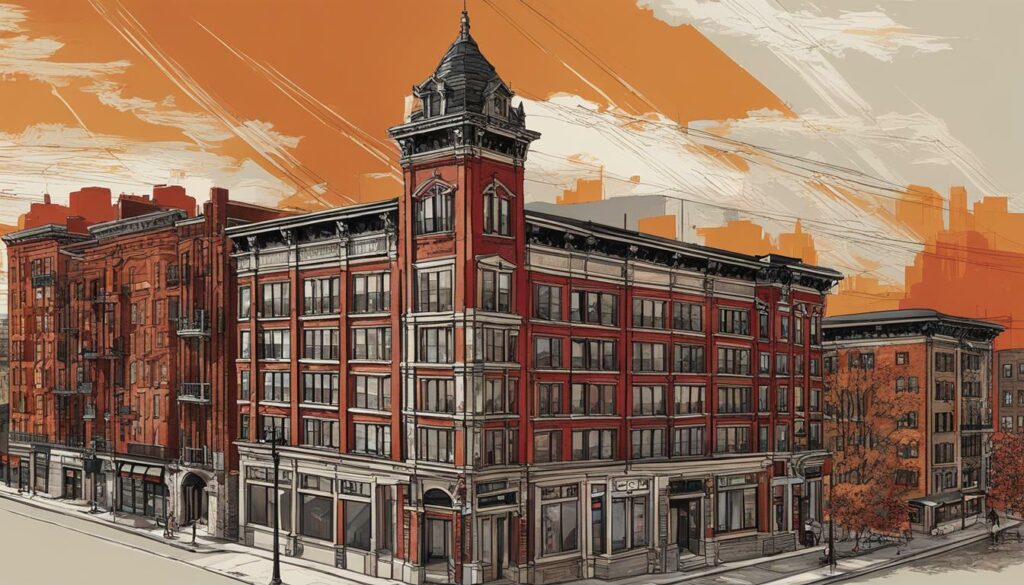
Bridgeport is known for its strong sense of community and is home to several historic sites that attract visitors and residents alike. The neighborhood’s close-knit nature is evident in its vibrant community events and local organizations that foster a sense of belonging.
One of the notable historic sites in Bridgeport is the Daley family home, where Richard J. Daley, the longest-serving mayor of Chicago, resided. The house stands as a symbol of the Daley family’s influence on Bridgeport and Chicago politics. Visitors can take a tour of the home and learn about the legacy of the Daley family.
Another iconic landmark is the Nativity of Our Lord church, a beautiful place of worship that has been a centerpiece of the Bridgeport community since its establishment. The church’s stunning architecture and rich history make it a must-visit for history enthusiasts and those interested in the neighborhood’s religious heritage.
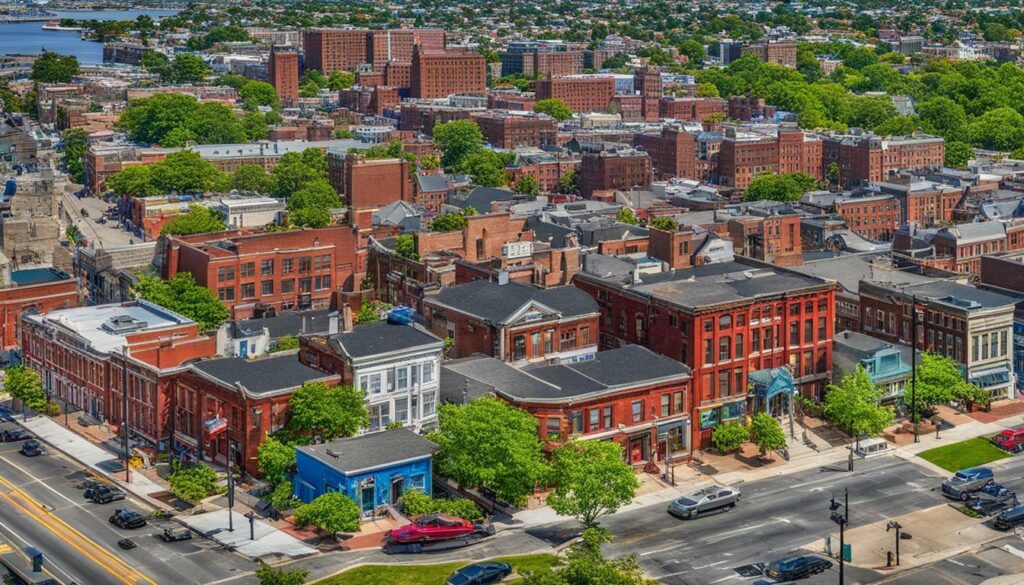
De La Salle high school, located in Bridgeport, is another significant historic site. Established in 1889, it has provided quality education to generations of students. The school’s rich cultural and educational heritage is celebrated, and it continues to shape the lives of young individuals in the neighborhood.
Lastly, the 11th Ward headquarters serves as a hub for political activity and community engagement. It is a place where residents come together to discuss local issues and actively participate in shaping the neighborhood’s future.
| Historic Sites | Description |
|---|---|
| Daley family home | The former residence of Richard J. Daley, a prominent figure in Chicago politics. |
| Nativity of Our Lord church | A stunning place of worship with a rich religious heritage. |
| De La Salle high school | An esteemed educational institution with a long-standing history. |
| 11th Ward headquarters | A community hub for political engagement and local discussions. |
Bridgeport: A Community Rooted in History
Bridgeport’s historic sites are a testament to its rich past and the enduring sense of community that has defined the neighborhood for centuries. These landmarks serve as reminders of the neighborhood’s cultural, political, and educational significance. Visitors and residents alike can explore these sites, immersing themselves in the history and spirit of Bridgeport.
As Bridgeport continues to evolve, it remains committed to preserving its heritage and fostering a sense of unity among its residents. The community’s close-knit nature and the presence of these historic sites contribute to the neighborhood’s unique charm and appeal.
Reflection on Bridgeport’s History
The history of Bridgeport offers a glimpse into the past, illuminating the neighborhood’s evolution and its impact on Chicago’s narrative. From its humble beginnings as a settlement for Irish immigrants in 1836, Bridgeport grew into a vibrant working-class community with a rich cultural heritage. The neighborhood’s early residents faced challenges and conflicts, but they also demonstrated resilience and determination.
One significant event in Bridgeport’s history was the violent labor protests that erupted at the Halsted Street Bridge in 1887. This event highlighted the struggles of workers and the tensions between labor and management during a time of rapid industrialization. Such historical landmarks remind us of the hardships faced by those who came before us and the importance of fighting for workers’ rights.
The Daley family, with its strong influence on Bridgeport and Chicago politics, has left an indelible mark on the neighborhood. Richard J. Daley, who served as mayor from 1955 to 1976, and his son Richard M. Daley, who served from 1989 to 2011, both hailed from Bridgeport. Their leadership and legacy have shaped the city’s political landscape and contributed to the neighborhood’s identity.
| Landmarks | Significance |
|---|---|
| The Daley Family Home | A symbol of Bridgeport’s political influence and a reflection of the Daley family’s legacy |
| Nativity of Our Lord Church | An important spiritual center for the community, representing the neighborhood’s strong Catholic roots |
| De La Salle High School | An esteemed educational institution that has nurtured generations of Bridgeport students |
| 11th Ward Headquarters | A hub for political organizing and a symbol of Bridgeport’s close-knit community |
Bridgeport’s history has not been without its challenges. Tensions and conflicts between different immigrant groups have emerged throughout the years, highlighting the complexities of Chicago’s diverse cultural landscape. The neighborhood has also experienced gang activity and cultural clashes, reflecting the struggles faced by communities striving for peace and unity.
Despite these challenges, Bridgeport has continued to thrive and grow. Today, the neighborhood boasts a vibrant arts and culture scene, with numerous dining options, art fairs, and farmers markets. These developments demonstrate the resilience and creativity of Bridgeport’s residents, who have worked diligently to create a welcoming and inclusive environment.
In conclusion, the history of Bridgeport is a testament to the determination and spirit of its residents. From its early days as a settlement for Irish immigrants to its present-day vibrancy, the neighborhood has played a significant role in shaping Chicago’s narrative. By reflecting on its past, Bridgeport continues to evolve, embracing its rich heritage while embracing the challenges and opportunities of the future.
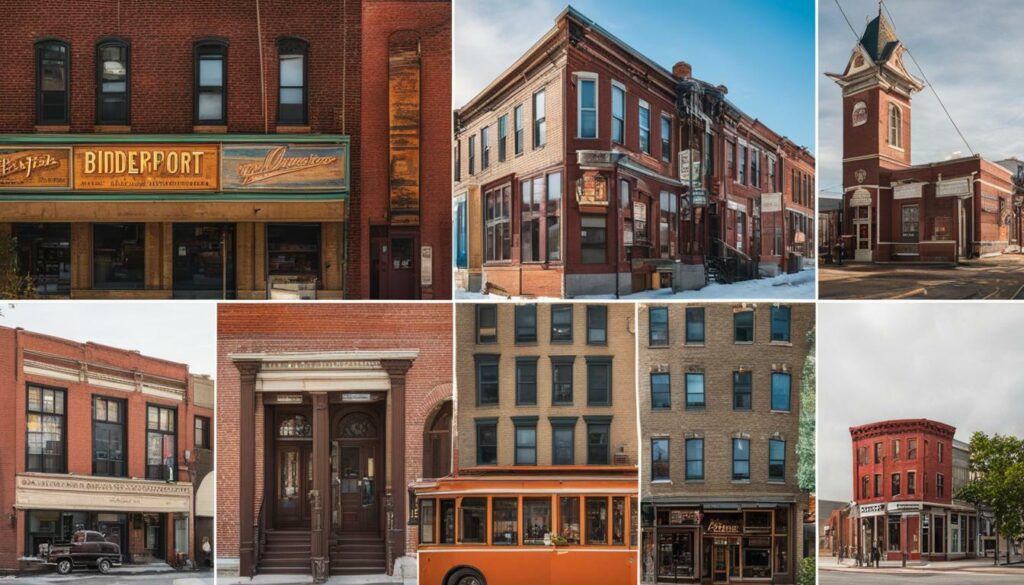
From its humble beginnings to becoming a cultural hub, Bridgeport’s history is a testament to the resilience and vibrancy of this Chicago neighborhood. First settled by Irish immigrants in 1836, Bridgeport quickly transformed into a working-class community with a strong sense of political organizing and conflict.
In 1887, the Halsted Street Bridge became the site of violent labor protests, marking a significant moment in Bridgeport’s history and highlighting its historical significance. Throughout the years, Bridgeport has been the birthplace of five Chicago mayors, including Richard J. Daley and his son Richard M. Daley, who left an indelible mark on both Bridgeport and Chicago politics.
Bridgeport has also witnessed tensions and conflicts between different immigrant groups, reflecting the complexities of Chicago’s culture and politics. Despite these challenges, the neighborhood has seen remarkable growth in its arts and culture scene, featuring an array of dining options, art fairs, and farmers markets that contribute to its vibrant atmosphere.
However, Bridgeport has not been without its share of struggles. Gang activity and cultural clashes have been a part of the neighborhood’s history, with various ethnic gangs operating in the area. Nevertheless, Bridgeport remains a close-knit community that takes pride in its landmarks, including the Daley family home, Nativity of Our Lord church, De La Salle high school, and the 11th Ward headquarters.
As we reflect on Bridgeport’s history, we recognize its rich tapestry and its ability to adapt and evolve over time. The story of this Chicago neighborhood serves as a microcosm of the larger city’s culture and politics, showcasing the diverse experiences and lasting impact of its residents.
FAQ
What is the history of Bridgeport, Chicago?
Bridgeport, a neighborhood in Chicago, has a rich and fascinating history. It was first settled by Irish immigrants in 1836 and later became a working-class community with strong political organizing and conflict.
What were the violent labor protests at the Halsted Street Bridge?
In 1887, violent labor protests took place at the Halsted Street Bridge in Bridgeport, Chicago, which had significant historical significance.
Which mayors of Chicago hail from Bridgeport?
Five Chicago mayors, including Richard J. Daley and his son Richard M. Daley, hail from Bridgeport, highlighting the neighborhood’s influence in Chicago politics.
How has Bridgeport’s arts and culture scene grown?
Bridgeport’s arts and culture scene has grown in recent years, with a variety of dining options, art fairs, and farmers markets.
What is the significance of the Daley family in Bridgeport and Chicago politics?
The Daley family, including Richard J. Daley and Richard M. Daley, has had a significant influence on Bridgeport and Chicago politics.
What tensions have existed between different immigrant groups in Bridgeport?
Throughout its history, Bridgeport has seen tensions and conflicts between different immigrant groups.
What landmarks are there in Bridgeport?
Bridgeport is home to significant landmarks such as the Daley family home, Nativity of Our Lord church, De La Salle high school, and the 11th Ward headquarters.
How has gang activity and cultural clashes shaped Bridgeport?
Bridgeport has had a history of gang activity and cultural clashes, reflecting the complexities of the neighborhood.
How does Bridgeport reflect the complexity and diversity of Chicago’s culture and politics?
Bridgeport’s history reflects the complexity and diversity of Chicago’s culture and politics.
Source Links
- https://interactive.wttw.com/chicago-by-l/neighborhoods/bridgeport
- https://www.chicagoganghistory.com/neighborhood/bridgeport/
- https://www.chicagomag.com/city-life/a-very-daley-tour-of-bridgeport/